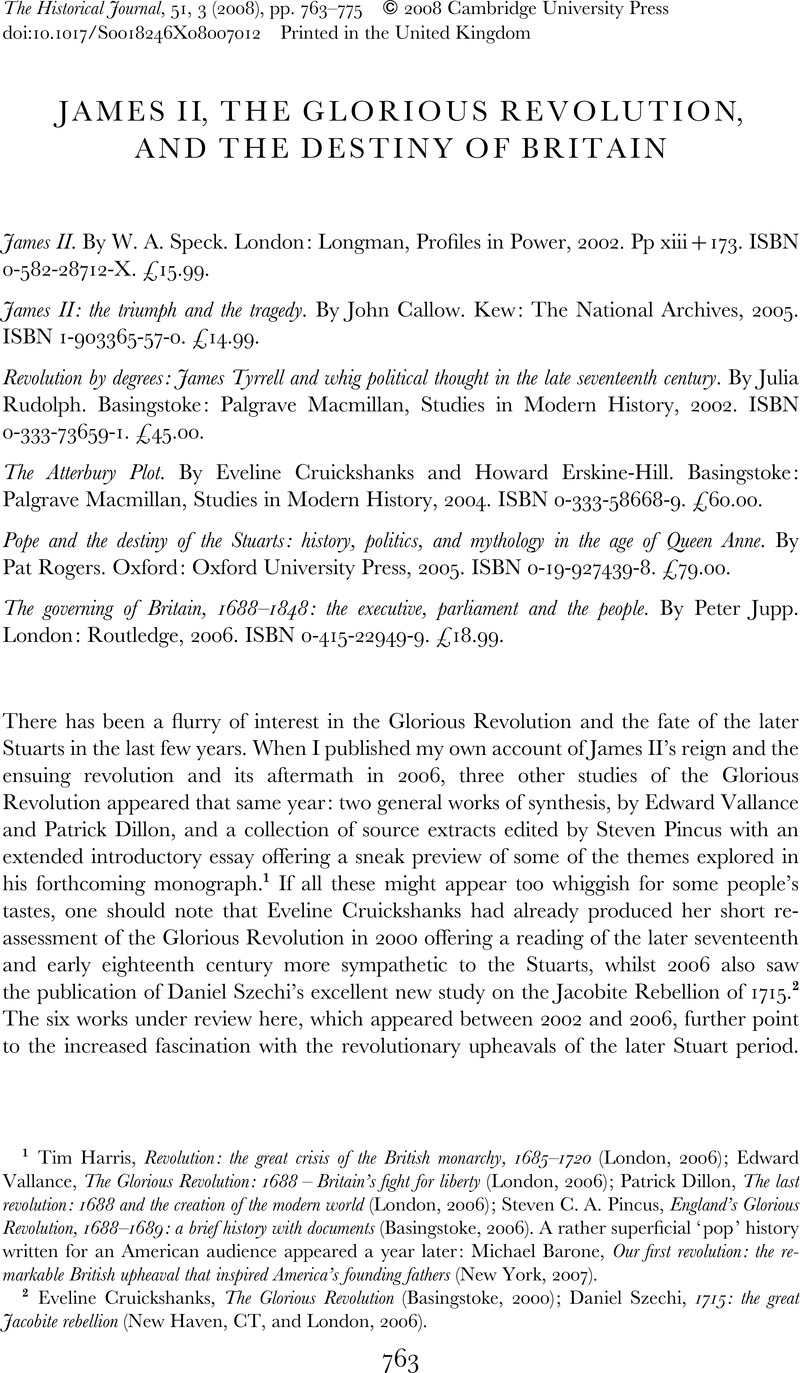Article contents
JAMES II, THE GLORIOUS REVOLUTION, AND THE DESTINY OF BRITAIN
Published online by Cambridge University Press: 04 September 2008
Abstract

- Type
- Review Article
- Information
- Copyright
- Copyright © 2008 Cambridge University Press
References
1 Tim Harris, Revolution: the great crisis of the British monarchy, 1685–1720 (London, 2006); Edward Vallance, The Glorious Revolution: 1688 – Britain's fight for liberty (London, 2006); Patrick Dillon, The last revolution: 1688 and the creation of the modern world (London, 2006); Steven C. A. Pincus, England's Glorious Revolution, 1688–1689: a brief history with documents (Basingstoke, 2006). A rather superficial ‘pop’ history written for an American audience appeared a year later: Michael Barone, Our first revolution: the remarkable British upheaval that inspired America's founding fathers (New York, 2007).
2 Eveline Cruickshanks, The Glorious Revolution (Basingstoke, 2000); Daniel Szechi, 1715: the great Jacobite rebellion (New Haven, CT, and London, 2006).
3 For a survey of the field as it stood a decade ago, see Tim Harris, ‘What's new about the Restoration?’, Albion, 29 (1997), pp. 187–222. New trends in late seventeenth-century studies were also mapped out in Harris, Tim, ed., ‘Special issue: the legacy of the English civil war’, The European Legacy, 5 (2000), pp. 501–76CrossRefGoogle Scholar.
4 W. A. Speck, The reluctant revolutionaries: Englishmen and the revolution of 1688 (Oxford, 1988).
5 Steve Pincus, ‘“To protect English liberties”: the English nationalist revolution of 1688–1689’, in Tony Claydon and Ian McBride, eds., Protestantism and national identity: Britain and Ireland, c. 1650–c. 1850 (Cambridge, 1998), pp. 75–104.
6 A foretaste is provided by Stanwood, Owen, ‘The Protestant moment: antipopery, the Revolution of 1688–1689, and the making of an Anglo-American empire’, Journal of British Studies, 46 (2007), pp. 481–508CrossRefGoogle Scholar.
7 John Callow, The making of King James II: the formative years of a fallen king (Stroud, 2000), and King in exile: warrior, king and saint, 1689–1701 (Stroud, 2004).
8 John Childs, The army, James II, and the Glorious Revolution (Manchester, 1980), pp. 1, 4.
9 One might note here The thoughts of a private person (London, 1689), a defence of the earl of Danby's uprising against James II in the north of England in November and December 1688, which Wing attributes to Danby himself. For Scotland see James Canaries, A sermon preached at Edinburgh … upon the 30th of January, 1689 (Edinburgh, 1689), which sought both to condemn Presbyterian resistance theory and at the same time legitimate episcopalian resistance to James II.
10 Gareth Vaughan Bennett, The tory crisis in church and state, 1688–1730: the career of Francis Atterbury bishop of Rochester (Oxford, 1975).
11 Lords Journal, xxii, p. 139.
12 Tim Harris, ‘Cooper, Anthony Ashley, first earl of Shaftesbury (1621–1683)’, Oxford dictionary of national biography, Oxford University Press, Sept. 2004; online edn, Jan. 2008 (http://www.oxforddnb.com/view/article/6208, accessed 14 Jan. 2008).
13 J. C. D. Clark, English society, 1688–1832: ideology, social structure, and political practice during the ancien regime (Cambridge, 1985); John Brewer, The sinews of power: war, money, and the English state, 1688–1783 (London, 1989).
14 Nick Harding, Hanover and the British empire, 1700–1837 (Woodbridge, 2007); Andrew C. Thompson, Britain, Hanover, and the Protestant interest, 1688–1756 (Woodbridge, 2006). The review editor of the Historical Journal had wanted me to include Thompson's book in my review, though I had to decline because it appeared in a series I edit.
15 Glickman, Gabriel, ‘The career of Sir John Hynde Cotton (1686–1752)’, Historical Journal, 46 (2003), pp. 817–41CrossRefGoogle Scholar. We await his The English Catholic community, 1688–1745: politics, culture and ideology (Woodbridge, forthcoming).
16 See in particular Éamonn Ó Ciardha, Ireland and the Jacobite cause, 1685–1766 (Dublin, 2002); Dickson, David, ‘Jacobitism in eighteenth-century Ireland: a Munster perspective’, Eire-Ireland, 39: 3 and 4 (Fall/Winter, 2004), pp. 38–99CrossRefGoogle Scholar.
- 3
- Cited by


